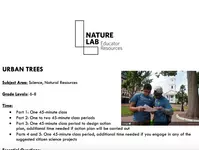https://www.nature.org/content/dam/tnc/nature/en/documents/nature-lab-lesson-plans/UrbanTrees-TeacherGuide.pdf
The Nature Conservancy
This learning activity takes five 45 minute class periods.
Learn more about Teaching Climate Literacy and Energy Awareness»Grade Level
Regional Focus
Online Readiness
Topics
Climate Literacy
This Activity builds on the following concepts of Climate Literacy.
Click a topic below for supporting information, teaching ideas, and sample activities.
Energy Literacy
This Activity builds on the following concepts of Energy Literacy.
Click a topic below for supporting information, teaching ideas, and sample activities.
Notes From Our Reviewers
The CLEAN collection is hand-picked and rigorously reviewed for scientific accuracy and classroom effectiveness.
Read what our review team had to say about this resource below or learn more about
how CLEAN reviews teaching materials
Teaching Tips | Science | Pedagogy |
Technical Details
Teaching Tips
- Thoroughly read the activity to identify what modifications are needed for your teaching context. Decide how you will assess students.
- There are numerous external links and resources provided with this lesson. Read through ahead of time to decide which ones you'd like students to utilize.
About the Content
- The science topic of this activity focuses on the many roles trees play in the lives of those living in urban areas, and the challenges trees face from invasive species and other threats.
- The videos within the activity provide the science for this lesson and appear to be up to date.
- There is an optional activity where students measure soil temperature near and away from trees which could be enhanced by more closely following the scientific process.
- In addition, the authors suggest using "mock data" if the school grounds do not have trees- If a tree is not available, then that part of the activity should be skipped instead of using made-up data.
- This resource could be strengthened by engaging students in a discussion about how urban trees can be carefully selected to combat climate change issues (drought and urban/forest fires, sea level rise and storm surge/flooding attenuation, etc.)
- Passed initial science review- expert science review pending.
About the Pedagogy
- This resource utilizes a variety of teaching methods including videos, tangible activity, discussion, and writing that will engage a diverse student audience.
- Much of the presented content in videos is specific to large cities in the eastern US, and students may have to use outside resources to understand how trees differ in their unique environment.
- From the steps in this activity, students will learn about trees, their roles in urban settings, threats to trees, and the overall value of the trees in their urban area.
- Students interact with videos, discuss related topics, and are tasked with creating an action plan to protect and promote trees in their communities.
- There is a good flow in the activity, however extra support could be provided for diverse learners and in assessing student work. Lesson uses 5E learning model.
Technical Details/Ease of Use
- This resource includes broken links for a necessary part of the lesson, tree identification. The dichotomous key on page 4 and 8 of the Teacher Guide is broken but teachers can utilize the [ link https://www.inaturalist.org 'iNaturalist'] or Leafsnap apps. For a dichotomous key, they can also used Arbor Day Foundation tree identifier.
- The Optional Activity during Part 1 of the lesson requires soil thermometers and some planning. The activity could be adapted to more closely resemble the process of science and incorporate some additional student-guided inquiry. However, the lesson could be completed without that activity. Finally, a few data tools are suggested, which may require teacher and student support to use them within this activity.
Related URLs These related sites were noted by our reviewers but have not been reviewed by CLEAN
- For Pages 9 and 10 for the Best Management Practices, use these links instead (from the same resource):
Nature.com's "Right Tree Right Place"
Best Management Practices: Tools of the Trade
Best Management Practices: Watering Your Tree
Tree Monitoring Schedule - For page 11 American Forests: Individual Tree Calculator Tools, instead use iTree tools for assessing individual trees.








